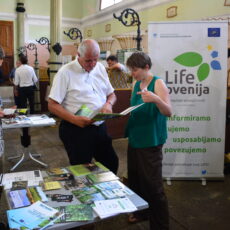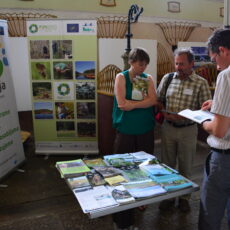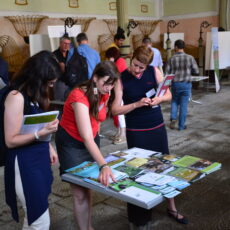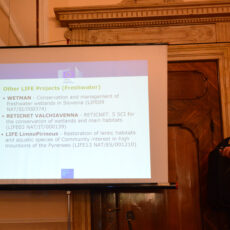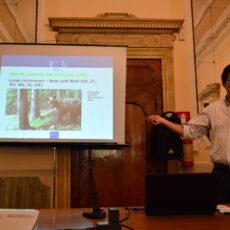Between June 21 and 23, 2017, team member of project LIFE CB SI participated in the second Alpine Natura 2000 Seminar, hosted by the University of Padua. The seminar offered participants an important opportunity to improve and strengthen the implementation of Natura 2000 in the region and to ensure progress in achieving the EU 2020 targets for biodiversity. In the knowledge exchange fair, we presented Slovenian LIFE projects, while Slovenian LIFE projects on large carnivores and the project WETMAN were also mentioned by NEEMO representative João Pedro Silva in his presentation of the LIFE programme and best practices in the Alpine biogeographical region.
The second Alpine Natura 2000 Seminar is part of the established Natura 2000 Biogeographical Process and was, as continuation of the first Alpine Seminar (held in October 2013 in Austrian Graz), hosted by the University of Padova, the Department of Land, Environment, Agriculture and Forestry (TESAF). It provided an important opportunity for participants to improve and strengthen the implementation of Natura 2000 in the Region and ensure progress towards the EU 2020 Biodiversity Strategy targets.
The aim of Alpine Seminar was to generate concrete outputs as identified by participants. Although some attention was given to reviewing progress since the first Alpine Seminar (held in Graz, Austria, 25 – 26 October, 2013), the focus was very much forward-looking – this included:
- Taking stock of the activities implemented since the kick-off seminar and identifying and agreeing further concrete actions and cooperation priorities, which can be developed and taken forward by various actors in the Region – with the aim of reaching favourable conservation status (FCS).
- Identifying possible new conservation issues/priorities – new cooperation actions based, in particular, on the lessons learnt from the latest State of Nature Report, including a ‘Roadmap’ of agreed future collaborative actions.
- Compiling sources of information and experience that capitalise on completed projects, available guidance and potential new proposals to increase synergies and collaboration opportunities.
The seminar also discussed:
- The possibilities and practicalities of identifying restoration priorities, including the so-called ‘low hanging fruit’ (LHF) i.e. habitat and species whose conservation status could be improved in the short-term using reasonably straightforward management measures. This reflects the urgency to demonstrate progress towards achieving the targets of the EU 2020 Biodiversity Strategy in the short to medium term.
- How to develop the most useful form of cooperation and implementation strategies for biogeographical level favourable reference values (FRVs).
- Any additional conservation issues of common interest that will have been identified in the expert consultation process preceding the seminar.
Over three days, more than 120 representatives from 17 member states participated in numerous workshops, round tables and knowledge fair. Aim of the latter was to promote discussions among participants, networking, exchange of experience and best practices, collecting information and providing useful contributions for the future projects and collaborations.
At the fair we presented some Slovenian LIFE projects, which contributed to improvement of conservation status of species and habitat types and better implementation of Habitats Directive in the Alpine biogeographical region: Besides the project LIFE Capacity Building Slovenia we presented and provided material on the following projects:
- SI Natura 2000 Upravljanje (LIFE11 NAT/SI/880) – Natura 2000 Management programme for Slovenia for the period 2014-2020,
- LIFE Artemis (LIFE15 GIE/SI/000770) – Awareness Raising, Training and Measures on Invasive alien Species in forests,
- LIFE DINALP BEAR (LIFE13 NAT/SI/000550) – Population level management and conservation of brown bears in northern Dinaric Mountains and the Alps,
- LIFE SloWolf (LIFE08 NAT/SLO/000244) – Conservation and surveillance of the conservation status of the wolf (Canis lupus) population in Slovenia,
- LIFE WOLFALPS (LIFE12 NAT/IT/000807) – Wolf in the Alps: Implementation of coordinated wolf conservation actions in core areas and beyond,
- WETMAN (LIFE 09NAT/SI/000374) – Conservation and management of freshwater wetlands in Slovenia,
- LIFE TO GRASSLANDS (LIFE 14 NAT/SI/000005) – LIFE Conservation and management of dry grasslands in Eastern Slovenia
- and a bit older project Peatbogs in Triglav National Park (LIFE00 NAT/SLO/007231).
The participants were mainly interested in how do we:
- address and solve conflicts, occurring during the management of large carnivores,
- tackle the biodiversity loss of grasslands and wetlands,
- fight against invasive species and
- manage Natura 2000 sites in Slovenia, considering the very high percentage of surface area.
Additional confirmation of successful LIFE story in Slovenia is the fact, that Slovenian LIFE projects on large carnivores and project WETMAN were also mentioned by NEEMO representative, João Pedro Silva, in his presentation on LIFE programme and best practices of LIFE projects in the Alpine biogeographical region.
The input documents and final reports of the seminar will be soon available at the Natura 2000 Communication Platform.
- Slovenian stand at knowledge exchange fair (Photo: Peter Skoberne)
- Slovenian stand at knowledge exchange fair (Photo: Peter Skoberne)
- Slovenian stand at knowledge exchange fair (Photo: Peter Skoberne)
- Slovenian stand at knowledge exchange fair (Photo: Peter Skoberne)
- NEEMO representative João Pedro Silva (Photo: Peter Skoberne)
- NEEMO representative João Pedro Silva (Photo: Peter Skoberne)






